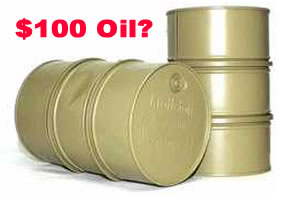Pain at the pumps: Companies brace for $100-a-barrel oil
 Crude oil markets are going out of 2010 like a lion – hitting two-year highs and raising predictions that prices will soon top $100 (U.S.) a barrel.
Crude oil markets are going out of 2010 like a lion – hitting two-year highs and raising predictions that prices will soon top $100 (U.S.) a barrel.For motorists and businesses such as airlines and trucking firms, the surge in crude prices has meant a pre-Christmas crunch in fuel costs, with average Canadian pump prices now at their highest levels since October, 2008. And there is no sign they are about to ease.
“I’m not too surprised by the lift above $90 and I think we have some further gains here going forward,” Jim Ritterbusch, a veteran independent analyst based near Chicago, said in an interview Thursday.
“I’m afraid we’re going to see $100 oil in the first quarter – unfortunately.”
He said the fragile American recovery is being constrained by higher oil prices, which are driven more by higher demand in emerging markets but also buoyed by recent signs of economic growth in the U.S.
Crude prices closed at $91.52 per barrel in trading on the New York Mercantile Exchange on Thursday, their highest point since the fall of 2008, when they were plunging from record levels that summer.
Oil prices have been climbing throughout the final quarter of 2010, after trading below $75 for much of September, and have risen nearly 4 per cent this week alone.
Analysts credited further signs of U.S. economic growth, continued strength in key emerging economies such as China, and speculative buying as the U.S. Federal Reserve has increased liquidity in the economy and investors have sought havens for investment.
“There is some momentum to the U.S. economy – not all the data is great, but it looks like consumers are starting to spend,” said Michael Lynch, president of Strategic Energy and Economic Research Inc.
“So it is that, and you continue to have the Fed putting money into the economy. And some of that is going into the oil space. But we’re not out of the recession yet by any means, so it certainly seems the fundamentals have not brought us back to these highs, at least not by themselves.”
Many analysts expect crude prices to retreat later in 2011, as supply from both the Organization of Petroleum Exporting Countries (OPEC) and non-OPEC countries ramps up. Unlike during the previous bout of triple-digit crude prices, OPEC has up to 6 million barrels per day of spare capacity. Most of that is in Saudi Arabia, which typically aspires to maintain moderate crude prices in order to encourage long-term global demand and discourage non-OPEC supply.
At the same time, Iraq is rebuilding its oil production capacity and is now pumping some 2.5 million barrels a day, with a target of at least doubling that.
As crude prices climbed this fall, gasoline, diesel and jet fuel costs rose sharply. Refiners who were under considerable pressure in 2009 have been able to rebuild their profit margins and pass through high feedstock costs to consumers.
In Canada, pump prices averaged $1.117 (Canadian) per litre this week, according to MJ Ervin & Associates. That’s the highest pump price since the week of Oct. 7, 2008, and 17-per-cent higher than the price of a year ago. Regular, unleaded gasoline hit an all-time high of $1.401 in July, 2008, when crude peaked at $147 (U.S.) per barrel.
Industry analyst Michael Ervin said refiners have not completely restored their traditional margins, and will remain under pressure given sluggish U.S. demand and an ongoing over-capacity in the refining sector. Canadian prices are heavily influenced by the American market.
Still, holiday motorists will be facing the highest December fuel prices on record, and transportation companies are feeling the crunch.
North American airlines may be poised to boost fares with fuel surcharges as crude oil moves closer to $100 a barrel, analysts said.
“Every dollar that fuel rises erodes their earnings,” Jim Corridore, a Standard & Poor’s equity analyst in New York, told Bloomberg News. “It’s not good news to see fuel prices back up. Once we start approaching $100 a barrel, you’ll start to see fuel surcharges come back.”
You can return to the main Market News page, or press the Back button on your browser.

